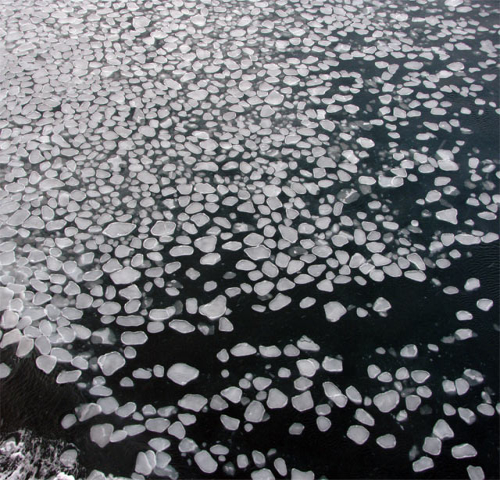Pancakes for breakfast? Lunch and dinner? We are surrounded with pancakes. Not ones made of flour, eggs and milk, but ones made of ice, pancake ice. Ice goes through many stages of freezing before it becomes a large floe of ice. There are even names for each stage. The first stage is the frazil stage when small crystals of ice start forming in the water. Next is the grease stage. It looks like a film of grease on the water.
 A film of ice.
A film of ice.
 Pancakes are not just for breakfast anymore.
Pancakes are not just for breakfast anymore.
Here come the pancakes, white, round and dotting the water. I was able to watch the pancakes develop from the size of a Frisbee to ones that are larger than a car. At one stage the pancakes join together to form a small ice cake. Ice cakes grow into ice floes. When the floes become larger they lose their round shape. Pancakes, ice cakes and floes can get pushed together by the wind. Many times when they push up against each other, pieces break off to form peaks called pressure ridges. Some of these pressure ridges can grow over 3 stories high. Other times, an ice floe can be pushed on top of another floe. This formation is called rafting. When you see very large open water in amongst the ice, it is called polynya. Small openings are called leads. On this expedition, we may not see a polynya, as they tend to occur in the same locations each year.
In the video, watch how the ice progresses from grease to floes.
http://
On board, Lead Scientist for the Sea Ice Project is Dr. Rolf Gradinger. Listen to the following interview as Rolf talks ice.
http://
David Forcucci, US Coast Guard Science Liason, captured this photo of water vapor rising from a lead.
 Not a typical view of an icescape
Not a typical view of an icescape
Quizzy Question: What causes the layers if the ice to have different colors? What colors do you see when the ice turns on its side?

